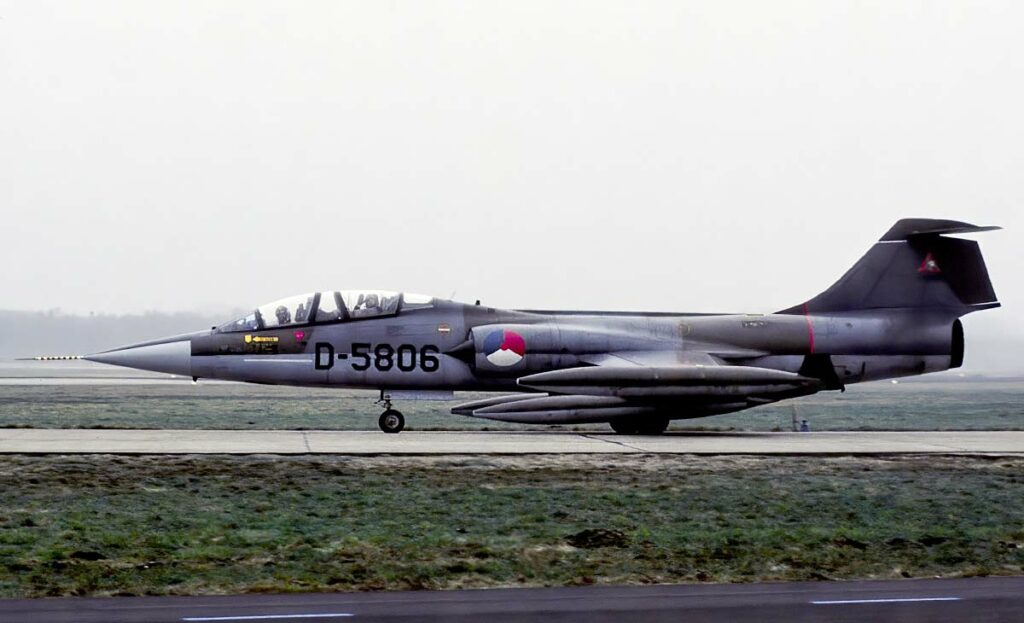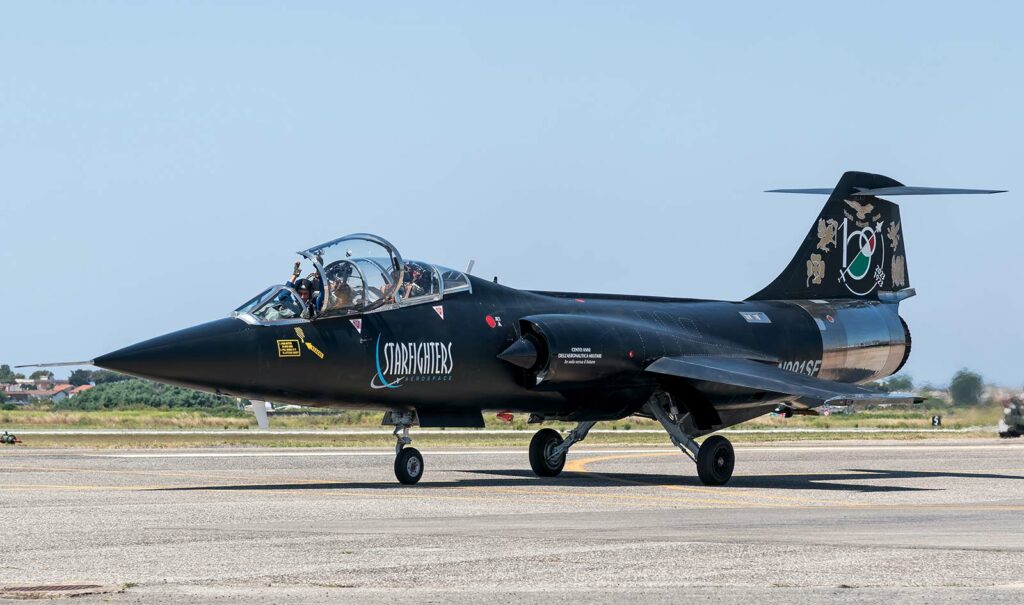The Lockheed F-104 Starfighter is a supersonic interceptor and air superiority fighter known for its high speed and climb performance.
In brief
The Lockheed F-104 Starfighter, developed in the early 1950s, is a single-engine, high-performance, supersonic interceptor aircraft. With its unique slender fuselage and T-tail, the F-104 was designed for speed and agility, featuring a radical wing design that was extremely thin and straight, allowing for minimal drag at high speeds. Powered by the General Electric J79 turbojet engine, the Starfighter was capable of reaching speeds in excess of Mach 2. Its armament included a 20mm M61 Vulcan cannon and the capability to carry missiles and bombs on underwing hardpoints. The F-104 set numerous speed and altitude records, serving in the air forces of several NATO countries and others around the world. Despite its impressive performance, the F-104 faced criticism for its high accident rate, earning it nicknames such as “The Widowmaker” in some circles.

History of the Development of the Lockheed F-104 Starfighter
In the context of the Cold War and the Korean War’s demonstration of the importance of air superiority, the United States Air Force (USAF) recognized the need for a new generation of supersonic fighters. Lockheed’s chief designer, Clarence “Kelly” Johnson, proposed a lightweight, high-speed interceptor that could outperform any existing aircraft. The project, initiated by Lockheed in the early 1950s without formal USAF approval, aimed to create an aircraft with unprecedented speed and climb capabilities to counter the Soviet bomber threat.
The Lockheed F-104 Starfighter first flew on March 4, 1954, marking the beginning of a new era in jet fighter design. The program was launched by Lockheed with the support of the USAF, seeking to leverage the latest advancements in aerodynamics and jet engine technology. The F-104’s development was driven by the need for a high-performance fighter that could engage enemy aircraft at altitudes and speeds previously unattainable.
While the F-104 did not receive a specific NATO nickname, its performance and design characteristics quickly made it a notable aircraft among NATO members and beyond. Its role was envisioned as both an interceptor capable of rapid response to enemy threats and an air superiority fighter that could dominate in dogfights.
Design of the Lockheed F-104 Starfighter
The Lockheed F-104 Starfighter featured a revolutionary design for its time. Its airframe was characterized by a slender fuselage and a very small wing area, with wings that were only 4 inches (10 cm) thick at the root, reducing drag at supersonic speeds. The wingspan measured 21 feet 9 inches (6.63 meters), and the length was 54 feet 8 inches (16.66 meters), with a height of 13 feet 6 inches (4.11 meters). This design enabled the F-104 to achieve high speeds and a climb rate that was unparalleled at the time.
The aircraft was powered by a General Electric J79 turbojet engine, capable of producing 15,800 pounds of thrust with afterburner, propelling the F-104 to speeds greater than Mach 2. The engine choice was a key factor in achieving the desired performance, providing the necessary power-to-weight ratio to meet the ambitious speed and altitude objectives.
The F-104’s design also included a unique T-tail configuration and a tricycle landing gear, with the main gear retracting into the wings. This was necessary due to the wings’ thin profile, which could not accommodate traditional landing gear wells. The aircraft was equipped with a 20mm M61 Vulcan cannon, housed in the fuselage, and had provisions for air-to-air missiles and bombs on underwing hardpoints.
While the design offered significant advantages in terms of speed and performance, it also presented drawbacks. The small wing area limited lift at lower speeds, contributing to challenging handling characteristics, especially during takeoff and landing. Additionally, the high landing speeds and susceptibility to stall in certain flight conditions led to a higher accident rate compared to other fighters of its era.
The F-104 Starfighter’s design represented a bold step forward in fighter technology, emphasizing speed, altitude capability, and firepower. Its contributions to aircraft design influenced future generations of fighters, despite the challenges and controversies it faced.
Performance of the Lockheed F-104 Starfighter
The performance of the Lockheed F-104 Starfighter set it apart from its contemporaries. Capable of exceeding speeds of Mach 2, the F-104 could reach a maximum speed of approximately 1,450 mph (2,334 km/h) at altitude. Its service ceiling was above 50,000 feet (15,240 meters), with an initial climb rate exceeding 50,000 feet per minute, showcasing its exceptional performance in reaching high altitudes quickly.
The F-104 was powered by the General Electric J79-GE-11A turbojet engine, which provided a thrust of 10,000 pounds-force (44.48 kN) dry and 15,800 pounds-force (70.28 kN) with afterburner. This engine was crucial in achieving the aircraft’s remarkable speed and climb capabilities.
In terms of range, the F-104G variant, for example, had a combat radius of approximately 420 miles (676 kilometers) on internal fuel, extendable with external fuel tanks. The aircraft’s design focused on maximizing speed and altitude performance, making it a formidable interceptor and air superiority fighter.
Compared to its contemporaries like the North American F-100 Super Sabre or the Soviet MiG-21, the F-104 Starfighter was notable for its superior top speed and climb rate. However, its operational effectiveness was sometimes limited by its relatively short range and challenging handling characteristics at lower speeds and altitudes.
The F-104’s performance in air-to-air combat and interception missions demonstrated its strengths as a high-speed, high-altitude fighter. Despite some limitations and a high accident rate, the Starfighter’s capabilities made it a valuable asset in the Cold War era, contributing to NATO’s deterrence posture.
Variants of the Lockheed F-104 Starfighter
The Lockheed F-104 Starfighter was produced in several variants, each designed for specific roles and requirements. The initial F-104A model was the first production version, primarily serving as an interceptor. The F-104C was a tactical strike variant equipped for nuclear delivery and in-flight refueling.
The F-104G model represented the most significant development, with improvements for all-weather capability, increased fuel capacity, and upgraded avionics, making it the most widely used variant by NATO countries. The TF-104G was a two-seat trainer version of the F-104G, providing pilot training without compromising combat capabilities.
The F-104S, developed for the Italian Air Force, was an advanced interceptor variant equipped with improved radar and missile systems, capable of carrying AIM-7 Sparrow missiles. Each variant of the F-104 incorporated specific modifications to enhance performance, survivability, and mission flexibility, reflecting the diverse operational needs of its users.

Military Use and Combat of the Lockheed F-104 Starfighter
The Lockheed F-104 Starfighter saw extensive military use across various NATO countries and other allied nations. Its primary armament included a 20mm M61 Vulcan cannon and the capability to carry air-to-air missiles such as the AIM-9 Sidewinder, in addition to bombs and nuclear weapons on its underwing hardpoints.
The F-104 was used in several conflicts, most notably by the Pakistan Air Force during the Indo-Pakistani Wars, where it conducted air-to-air and ground-attack missions. Its performance in combat demonstrated both its strengths as a high-speed interceptor and its limitations in close air support roles.
The aircraft competed with contemporaries like the MiG-21 and the McDonnell Douglas F-4 Phantom II, offering unique advantages in speed and altitude but facing challenges in maneuverability and range. The F-104 was sold to various countries, including Germany, Italy, Canada, and Japan, among others, under the Military Assistance Program, which facilitated its widespread adoption.
While some nations have retired the F-104 from active service, it remains in limited use for research and training purposes in some countries. The Starfighter was eventually replaced by more modern aircraft such as the F-16 Fighting Falcon, which offered improved performance, versatility, and safety.
The Lockheed F-104 Starfighter represents a pivotal chapter in the history of military aviation, introducing revolutionary design and performance characteristics that pushed the boundaries of fighter aircraft capabilities. Despite its controversial operational record, the Starfighter’s contributions to supersonic flight and air combat tactics have left a lasting legacy. Its development, operational history, and technological advancements reflect the challenges and achievements of aerospace engineering during the Cold War, influencing future generations of aircraft design and military strategy.
Back to the Fighter Jet section.